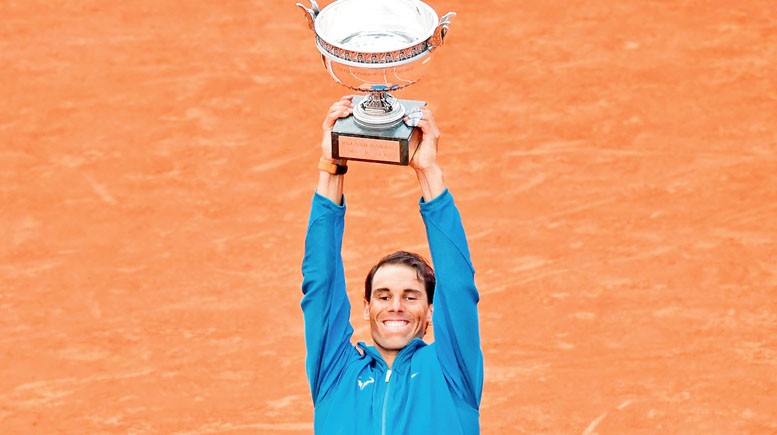
The next few majors could provide Nadal the opportunity to add to his tally, even if Federer - five years his senior - would be the favourite at Wimbledon and even the US Open

Last Sunday, World No 1 Rafael Nadal won his record extending 11th French Open title. It was his 17th Grand Slam title, bringing him back to within three of Roger Federer (20), second on the all-time list.
While his all-court accolades make him the second most illustrious male tennis player of all time, his numbers of clay are unparalleled in all of sport.
In addition to 11 Roland Garros trophies, he has the same number of titles at Monte Carlo and Barcelona – with another eight at Rome as well. Nadal now has 57 titles on clay, and won 50 consecutive sets on the surface between Rome Masters 2017 and Madrid Masters this year. All of these achievements are all-time records.
While facing Nadal on clay remains the most daunting task in tennis, doing so in a best of five format is the ultimate challenge. Following his win on Sunday, Nadal is now 111-2 in best of five clay court matches, and 86-2 at the French Open.
Since making his debut at Roland Garros in 2005, Nadal has only lost two matches at the tournament. Robin Soderling (4th round, 2009) and Novak Djokovic (QF, 2015), remain the only two players to have beaten Nadal at Roland Garros, with the Spaniard having to withdraw ahead of his third round match in 2016.
As Nadal continues to not just extend his own records, but define an entire sport, the natural question that has followed over the years is just how much would he have achieved by the time he hangs up his boots.
Nadal himself is quick to ward off these questions considering that doctors had almost put a curtain call on his professional career before it even began. Even after his win on Sunday Nadal confessed that he thought he’d "have retired" by now.
He even insisted that – unlike those of us who write and debate about the sport – he isn’t thinking about Federer’s record major tally, and what is most important for him is "to be healthy and happy."
And so, inherent to the very question of how many accolades Nadal can win is the question over his own body, that has already outlasted what everyone – including the man himself and his team – had predicted.
And yet considering his recent dominance one can’t but feel that there still is a lot more to come from Rafa.
For starters, he has had two of the most dominant seasons on clay on the other side of 30, over the past couple of years. In his last two French Open title runs he has collectively dropped only a single set. In the last two finals he lost a combined 15 games to a former Roland Garros champion and one who looks the likeliest among the rest to be a victor at the French Open in the near future.
Of the almost decade and a half of ruling the surface, the recent dominance is unparalleled even for Nadal himself.
Therefore, if health permits, it is very likely that Nadal would be the favourite to win the next couple of Roland Garros titles as well.
From overcoming Mariano Puerta in 2005 to beating Dominic Thiem in 2018, Nadal is currently taking on the third generation of players – and beating them convincingly. And how soon the likes of Thiem and Alexander Zverev can up their level to Grand Slam level, would determine how many more Roland Garros titles Nadal can win, and perhaps how long he’d continue to ply the trade.
With Nadal deciding against predicting the watch, and the fact that Roger Federer – who has split the last six majors with Rafa – continues to win majors approaching 36 years of age, there still should be a lot more to come from the Spanish maestro, if he manages to schedule his seasons properly.
While Nadal remains the undisputed ‘King of Clay’, he has a hall of fame legacy outside of his favourite surface as well. With his peers Djokovic, Andy Murray and Stan Wawrinka traversing respective declines and injury troubles, and the younger lot yet to make a major breakthrough, there are titles to be had for Nadal elsewhere as well.
Nadal won the US Open and was the runners-up in Australia last year as well. He looked good to set up a rematch of the 2017 final in Australia against Federer this year, before injury forced him to retire in the quarterfinals against Marin Cilic. Nadal played his best Wimbledon since 2011 last year as well, eventually coming undone against Gilles Muller’s devastating grass-court prowess.
With each of the last seven male Grand Slam title winners being over 30, and Cilic – who’ll turn 30 this year – being the runner-up at Wimbledon 2017 and Australia this year, it is evident that enhancement in sports science and technology has moved the peak age of athletes upwards.
Furthermore, with Nadal changing his style of play to keep the rallies short, having lost a yard of pace over the past decade, he could well capitalise on major openings outside of Roland Garros as well.
The next few majors could provide Nadal the opportunity to add to his tally, even if Federer – five years his senior – would be the favourite at Wimbledon and even the US Open.
It is, however, unlikely that Nadal would be challenging for majors when he’s approaching 37, given the grinding that he’s given his body over the past decade and a half. But then again nobody thought he’d be playing at 32, let alone winning Grand Slam titles – not even Nadal himself.